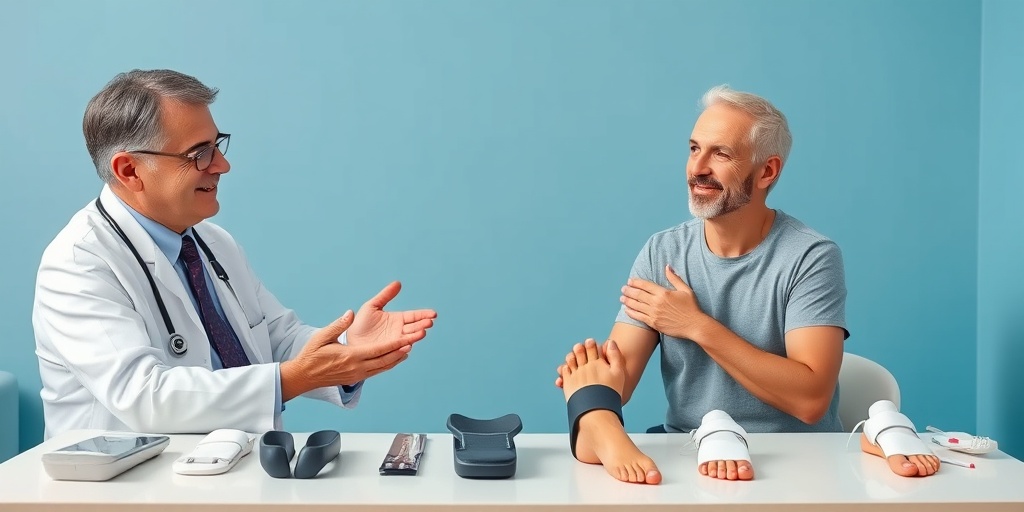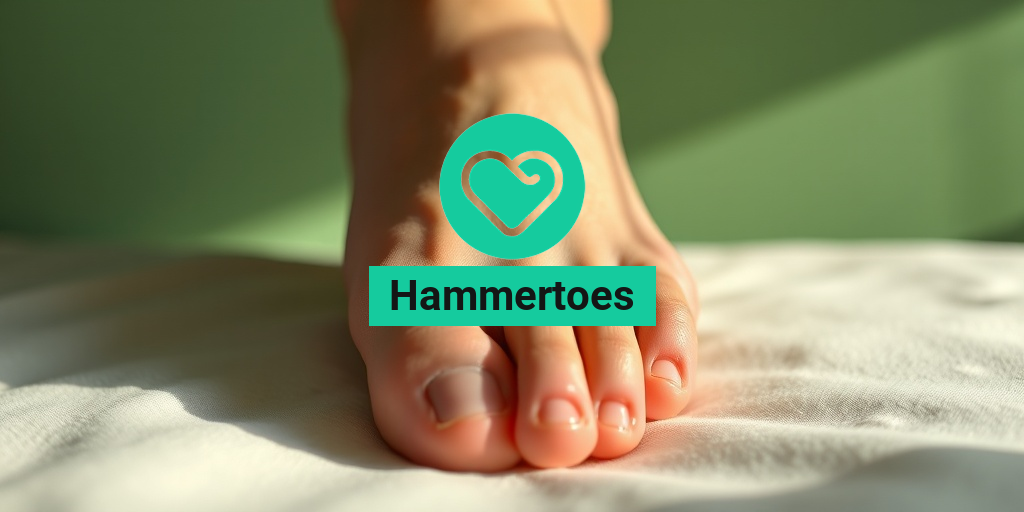What Are Hammertoes?
Hammertoes are a common foot condition characterized by an abnormal bend in the middle joint of one or more toes, causing them to resemble a hammer. This deformity can affect any toe but is most frequently seen in the second, third, or fourth toes. The condition can develop due to various factors, including genetics, improper footwear, or underlying health issues.
Understanding the Anatomy of Hammertoes
To better grasp what hammertoes are, it’s essential to understand the anatomy of the foot. Each toe consists of three bones (except for the big toe, which has two) connected by joints. When the muscles and tendons that control the toe become imbalanced, it can lead to the characteristic bending of the toe. This imbalance can be caused by:
- Muscle Weakness: Weakness in the muscles that support the toe can lead to its abnormal positioning.
- Footwear Choices: Shoes that are too tight or have high heels can contribute to the development of hammertoes.
- Genetics: A family history of foot problems can increase the likelihood of developing hammertoes.
- Medical Conditions: Conditions such as arthritis or diabetes can also play a role in the development of this deformity.
Types of Hammertoes
Hammertoes can be classified into two main types:
- Flexible Hammertoes: In the early stages, the toe can still be straightened manually. This type is often less painful and easier to treat.
- Rigid Hammertoes: Over time, the toe may become fixed in its bent position, making it more challenging to treat and often resulting in increased pain.
Hammertoes Symptoms
Recognizing the symptoms of hammertoes is crucial for early intervention and treatment. Here are some common symptoms associated with this condition:
Visible Deformity
The most apparent symptom of hammertoes is the visible bending of the toe. This deformity can vary in severity, with some toes appearing more pronounced than others. In some cases, the affected toe may overlap with adjacent toes, leading to further complications.
Pain and Discomfort
Individuals with hammertoes often experience pain, especially when wearing shoes. The pressure from footwear can exacerbate discomfort, leading to corns or calluses on the top of the affected toe. This pain can be sharp or throbbing and may worsen with prolonged standing or walking.
Swelling and Redness
Inflammation around the affected joint is another common symptom. The toe may appear swollen and red, indicating irritation or inflammation. This can be particularly noticeable after wearing tight shoes or engaging in activities that put stress on the toes.
Difficulty Moving the Toe
As hammertoes progress, individuals may find it increasingly challenging to move the affected toe. This stiffness can limit mobility and make it difficult to perform daily activities, such as walking or exercising.
Other Associated Conditions
Hammertoes can sometimes occur alongside other foot conditions, such as bunions. Bunions are bony bumps that form at the base of the big toe, and their presence can complicate the treatment of hammertoes. If you notice symptoms of both conditions, it’s essential to consult a healthcare professional for a comprehensive evaluation.
When to Seek Medical Advice
If you experience persistent pain, swelling, or difficulty moving your toes, it’s crucial to seek medical advice. Early intervention can prevent the condition from worsening and may involve non-surgical treatments such as physical therapy, orthotic devices, or changes in footwear. For more detailed information and resources, consider visiting Yesil Health AI, where you can find evidence-based health answers.
In conclusion, understanding hammertoes and their symptoms is vital for effective management and treatment. By recognizing the signs early, you can take proactive steps to alleviate discomfort and maintain your foot health. Remember, your feet carry you through life, so it’s essential to care for them! 👣

Causes of Hammertoes
Hammertoes are a common foot condition characterized by an abnormal bend in the middle joint of the toe, causing it to resemble a hammer. Understanding the causes of hammertoes is essential for prevention and effective treatment. Here are some of the primary factors that contribute to the development of this condition:
1. Muscle Imbalance
One of the leading causes of hammertoes is a muscle imbalance in the foot. When the muscles and tendons that control the toe movement become weak or imbalanced, it can lead to the toe bending inappropriately. This imbalance may be due to:
- Overuse: Repetitive activities that put stress on the toes can lead to muscle fatigue.
- Injury: Trauma to the foot can disrupt the normal functioning of the muscles and tendons.
2. Improper Footwear
Wearing shoes that do not fit properly is another significant cause of hammertoes. Shoes that are too tight, narrow, or have high heels can force the toes into an unnatural position, leading to deformities over time. It’s crucial to choose footwear that provides adequate space for your toes to move freely.
3. Genetics
Genetics can play a role in the development of hammertoes. If you have a family history of foot problems, you may be more susceptible to developing this condition. Certain inherited traits can affect the structure of your feet and the way your muscles function.
4. Arthritis
Arthritis, particularly rheumatoid arthritis, can contribute to the development of hammertoes. This inflammatory condition can cause joint pain and stiffness, leading to changes in the way you walk and the positioning of your toes.
5. Neuromuscular Disorders
Conditions that affect the nerves and muscles, such as cerebral palsy or Charcot-Marie-Tooth disease, can also lead to hammertoes. These disorders can disrupt the normal functioning of the muscles in the feet, resulting in deformities.
Risk Factors for Hammertoes
While anyone can develop hammertoes, certain risk factors increase the likelihood of experiencing this condition. Being aware of these factors can help you take preventive measures:
1. Age
As we age, the risk of developing hammertoes increases. The natural wear and tear on our joints and muscles can lead to imbalances that contribute to toe deformities. Older adults are particularly susceptible due to decreased muscle strength and flexibility.
2. Gender
Women are more likely than men to develop hammertoes, primarily due to the types of footwear they often wear. High heels and narrow shoes can exacerbate the problem, leading to a higher incidence of toe deformities among women.
3. Foot Structure
Individuals with certain foot structures, such as flat feet or high arches, may be at a greater risk for developing hammertoes. These structural issues can affect the way weight is distributed across the foot, leading to muscle imbalances.
4. Previous Foot Injuries
Having a history of foot injuries can increase the risk of hammertoes. Injuries can alter the mechanics of the foot, leading to changes in how the toes function and potentially resulting in deformities.
5. Certain Medical Conditions
Medical conditions such as diabetes, which can affect nerve function and circulation, may also increase the risk of developing hammertoes. Additionally, conditions like gout can lead to joint inflammation, further contributing to toe deformities.
Understanding the causes and risk factors associated with hammertoes is crucial for prevention and management. By being proactive about foot health and making informed choices regarding footwear and lifestyle, you can reduce your risk of developing this common condition. 🦶✨

Diagnosing Hammertoes
Hammertoes are a common foot condition that can cause discomfort and affect your mobility. Understanding how to diagnose this condition is crucial for effective treatment. Let’s explore the signs and symptoms that can help identify hammertoes.
What Are Hammertoes?
Hammertoes refer to a deformity of the second, third, or fourth toes, where the middle joint bends downward, resembling a hammer. This condition can develop due to various factors, including genetics, ill-fitting shoes, or muscle imbalances. Recognizing the symptoms early can lead to better management.
Common Symptoms of Hammertoes
Identifying hammertoes involves looking for specific symptoms, which may include:
- Pain or discomfort in the affected toe, especially when wearing shoes.
- Visible deformity of the toe, with a bent appearance.
- Swelling or redness around the joint.
- Calluses or corns on the top of the toe or on the ball of the foot due to friction.
- Difficulty moving the affected toe.
How is Hammertoes Diagnosed?
To diagnose hammertoes, a healthcare professional will typically perform the following steps:
- Physical Examination: The doctor will examine your feet and toes, looking for signs of deformity, swelling, and any associated pain.
- Medical History: Discussing your medical history, including any previous foot injuries or conditions, can provide valuable insights.
- X-rays: In some cases, X-rays may be ordered to assess the severity of the deformity and to rule out other conditions.
Early diagnosis is essential to prevent further complications, such as bunions or arthritis. If you suspect you have hammertoes, consult a podiatrist for a thorough evaluation. 🦶
Hammertoes Treatment Options
Once diagnosed, there are several treatment options available for managing hammertoes. The choice of treatment often depends on the severity of the condition and the level of discomfort experienced.
Conservative Treatment Options
For mild cases of hammertoes, conservative treatments can be effective:
- Footwear Modifications: Wearing shoes with a wide toe box can alleviate pressure on the toes. Avoiding high heels and tight shoes is crucial.
- Orthotic Devices: Custom orthotics or toe spacers can help realign the toes and provide support.
- Exercises: Specific hammertoes exercises can strengthen the muscles in your feet and improve flexibility. Simple stretches and toe curls can be beneficial.
- Padding and Taping: Using pads to cushion the affected toe or taping it in a straight position can reduce discomfort.
Medical Treatments
If conservative measures do not provide relief, medical treatments may be necessary:
- Injections: Corticosteroid injections can help reduce inflammation and pain in the affected area.
- Physical Therapy: A physical therapist can guide you through exercises and stretches tailored to your condition.
Surgical Options
In severe cases where conservative treatments fail, surgery may be considered. Surgical options can include:
- Toe Realignment: This procedure involves straightening the affected toe and may include tendon lengthening or shortening.
- Joint Resection: Removing a portion of the joint can relieve pain and improve function.
- Fusion: In some cases, fusing the bones in the toe may be necessary to stabilize the joint.
It’s essential to discuss all treatment options with your healthcare provider to determine the best course of action for your specific situation. Remember, early intervention can lead to better outcomes and improved quality of life. 🌟

Home Remedies for Hammertoes
Hammertoes can be a painful and uncomfortable condition, but there are several home remedies that can help alleviate symptoms and improve foot health. These remedies focus on relieving pain, reducing inflammation, and promoting better foot alignment. Here are some effective strategies you can try at home:
1. Stretching Exercises
Regular stretching can help improve flexibility and reduce tension in the toes. Here are a few exercises to consider:
- Toe Stretch: Sit in a chair and place your foot on your opposite knee. Gently pull your toes back towards your ankle and hold for 15-30 seconds.
- Marble Pickup: Place marbles on the floor and use your toes to pick them up one by one. This exercise strengthens the toe muscles.
- Toe Flexion: While seated, try to curl your toes under and then straighten them out. Repeat this motion 10-15 times.
2. Ice Therapy
Applying ice to the affected area can help reduce swelling and numb the pain. Wrap ice in a cloth and apply it to your toes for 15-20 minutes several times a day. This is especially helpful after long periods of standing or walking.
3. Footwear Adjustments
Wearing the right shoes is crucial for managing hammertoes. Look for shoes that have:
- Wide Toe Boxes: This allows your toes to move freely without being cramped.
- Arch Support: Proper arch support can help distribute weight evenly across your feet.
- Cushioned Soles: Shoes with cushioned soles can absorb shock and reduce pressure on your toes.
4. Padding and Splints
Using toe pads or splints can help realign your toes and provide cushioning. These can be found at most drugstores and can be worn throughout the day or while sleeping. They help reduce friction and pressure on the affected toes, providing relief from discomfort.
5. Epsom Salt Soaks
Soaking your feet in warm water mixed with Epsom salt can help relax the muscles and reduce inflammation. Aim for a soak of 15-20 minutes, and consider doing this a few times a week for best results. The magnesium in Epsom salt can also help soothe sore muscles.
6. Essential Oils
Some essential oils, such as peppermint or lavender, can provide relief from pain and inflammation. Dilute a few drops of essential oil in a carrier oil and massage it into the affected area. This can also promote relaxation and improve circulation.
Preventing Hammertoes
While some factors contributing to hammertoes are genetic, there are several proactive steps you can take to prevent hammertoes from developing or worsening. Here are some effective prevention strategies:
1. Choose the Right Footwear
As mentioned earlier, wearing shoes that fit well is essential. Avoid high heels and shoes with narrow toe boxes, as they can force your toes into unnatural positions. Instead, opt for:
- Comfortable Sneakers: Look for shoes that provide ample support and cushioning.
- Orthopedic Shoes: If you have existing foot issues, consider investing in orthopedic shoes designed to support foot health.
2. Maintain a Healthy Weight
Excess weight can put additional pressure on your feet, increasing the risk of developing hammertoes. Maintaining a healthy weight through a balanced diet and regular exercise can help reduce this risk. Aim for a diet rich in fruits, vegetables, whole grains, and lean proteins.
3. Regular Foot Care
Taking care of your feet is crucial for preventing hammertoes. This includes:
- Regularly Trimming Toenails: Keep your toenails trimmed straight across to prevent ingrown toenails.
- Moisturizing: Keep your feet moisturized to prevent dry skin and cracking.
4. Foot Exercises
Incorporating foot exercises into your daily routine can strengthen the muscles in your feet and toes. Simple activities like toe curls, ankle rotations, and walking barefoot on different surfaces can enhance foot strength and flexibility.
5. Be Mindful of Foot Injuries
Injuries to the foot can lead to misalignment and contribute to the development of hammertoes. If you experience any foot injuries, seek prompt medical attention to prevent complications.
By implementing these home remedies and preventive measures, you can manage hammertoes effectively and maintain better foot health. Remember, if symptoms persist or worsen, it’s essential to consult a healthcare professional for further evaluation and treatment. 🦶✨

Frequently Asked Questions about Hammertoes
What are Hammertoes?
Hammertoes are a foot condition characterized by an abnormal bend in the middle joint of a toe, causing it to resemble a hammer. This condition often affects the second, third, or fourth toes and can lead to discomfort and difficulty in walking.
What causes Hammertoes?
The primary causes of hammertoes include:
- Genetic predisposition
- Wearing ill-fitting shoes
- Muscle imbalances in the foot
- Injury to the toe
What are the symptoms of Hammertoes?
Common symptoms of hammertoes include:
- Pain or discomfort in the affected toe
- Swelling and redness
- Difficulty in finding comfortable footwear
- Calluses or corns on the top of the toe
How can Hammertoes be treated?
Treatment options for hammertoes vary based on severity and may include:
- Wearing properly fitting shoes
- Using orthotic devices
- Physical therapy and exercises
- Surgery in severe cases
Are there exercises for Hammertoes?
Yes! Specific hammertoes exercises can help improve flexibility and strength in the toes. Some effective exercises include:
- Toe stretches
- Picking up marbles with your toes
- Using a towel to pull your toes
What is the difference between Hammertoes and Claw Toes?
While both hammertoes and claw toes involve abnormal bending of the toes, the key difference lies in the position of the joints. Hammertoes typically have a bend in the middle joint, while claw toes have a bend at both the middle and end joints, causing the toe to curl downwards.
Can Hammertoes lead to other foot problems?
Yes, untreated hammertoes can lead to complications such as bunions, corns, and calluses, as well as increased pain and difficulty in walking.
Is surgery necessary for Hammertoes?
Surgery for hammertoes is generally considered when conservative treatments fail to provide relief. The decision to undergo surgery should be made in consultation with a healthcare professional.
Where can I find more information on Hammertoes?
For more detailed information, consider consulting a podiatrist or exploring reputable health websites that specialize in foot conditions.




